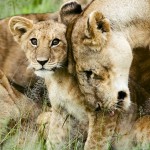
In Episode 40 of the Behind the Schemes podcast, we are talking to Dr. Pieter Kat and Christine Macsween about one of the most recognizable – but least protected – species on the Planet: the African lion.
The African lion has been listed on CITES Appendix II since 1977, which means that for nearly four decades, African lions – and their parts – have been traded legally. However, it is important to keep in mind that the regulating and monitoring of trade in Appendix II species is primarily up to the range countries. What this means is that Appendix II can be used to protect a species – or Appendix II can be used to exploit a species. It’s all in the implementation.
Unfortunately, implementation of CITES Appendix II has been weak, and has failed to protect African lions.
Although some organizations have recently attempted to downplay the threats posed by trade in lion bones and body parts, we believe those threats are significant and should not be brushed aside. The fact is that while legal international trade in African lions and the number of captive-bred lions have increased significantly in recent years, wild African lion populations have declined.
Have a listen to what Dr. Pieter Kat and Christine Macsween of LionAid have to say about the state of the African lion and the haunting spectre of trade.
Timestamps
[04:34] Pieter talks about regional African lion subspecies and the African lion proposal.
[06:25] Pieter explains potential opposition to the African lion proposal.
[07:43] Pieter reveals disturbing information about African lion population counts.
[10:09] Pieter talks about South Africa’s captive-bred lions and the Appendix I listing.
[12:30] Pieter warns about threats to wild lion populations posed by South Africa’s captive breeding operations.
[13:28] Pieter warns about increasing demand for lion “products.”
[14:31] Pieter explains how the lion bone trade can be stopped – but why it won’t.
[16:56] Chris explains LionAid’s initiative to educate children around the world about lions.
[20:51] Chris talks about LionAid’s visit to New Jersey Senator Raymond Lesniak.
[24:19] Chris explains the need to phase out the captive breeding of lions for “canned” hunting and cub-petting schemes.
- Subscribe to the Behind the Schemes podcast on iTunes
Help fight against wildlife trafficking: Support our work to advocate for the protection of endangered species at the upcoming CITES CoP17 in South Africa.




![South Africa’s Latest Rhino Horn Trade Shenanigans [Podcast]](https://annamiticus.com/wp-content/uploads/2017/02/BehindTheSchemesEpisode43-FINAL-150x150.png)